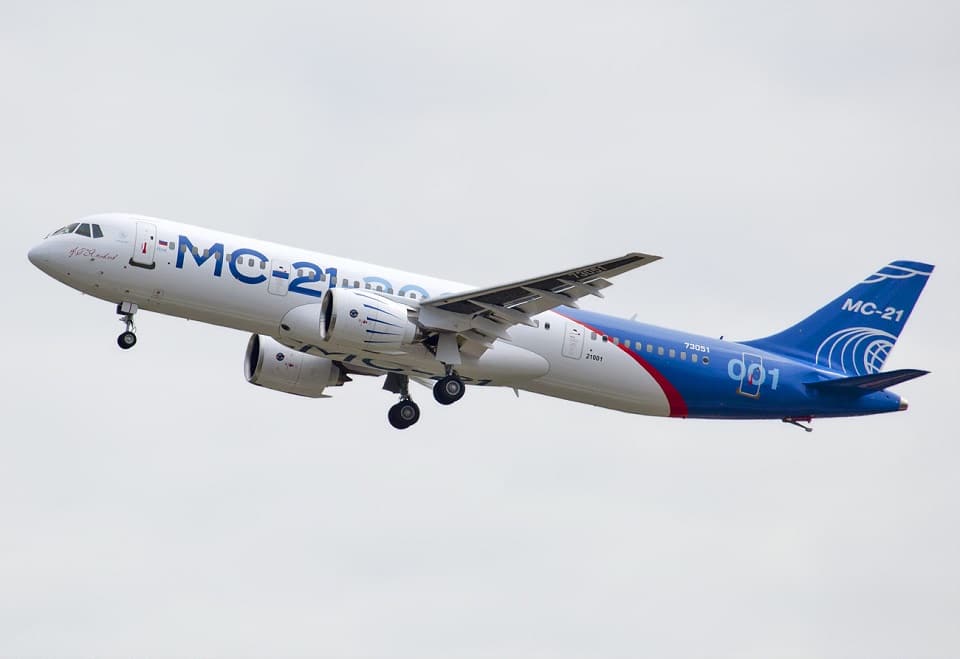Aviation
Syrianair Eyes Acquisition of Russian MC-21-310 Aircraft

Syria are exploring the possibility of acquiring MC-21 aircraft, but geopolitical tensions and U.S. sanctions are creating significant challenges. Syrianair, in particular, is struggling with operational difficulties due to these sanctions. Most of its fleet remains grounded, and the airline’s ability to expand its network is severely constrained by limited access to fuel rights.
Syrian Airlines, known as Syrianair, is actively pursuing the acquisition of modern Russian MC-21-310 passenger aircraft, as part of its strategy to enhance its fleet and expand operational capabilities. Hatem Kabbas, the Director General of Syrianair, has outlined the airline’s ambitions and the challenges it faces in this endeavor.
Russian Airlines Are Still Getting American Parts Despite Sanctions:Click here
Kabbas emphasized that the airline is not only seeking to acquire these advanced aircraft but is also keen on forging a partnership to transfer expertise. This includes developing training programs focused on aviation security, safety, and air navigation. The aim is to improve the operational efficiency of Syrianair and ensure adherence to international aviation standards.
However, the path to acquiring these aircraft is fraught with difficulties. Both Syria and Russia are working to overcome substantial obstacles, primarily stemming from the stringent U.S. sanctions and blockades imposed on Syria. These sanctions have significantly impacted Syrianair’s operations, with most of its fleet currently grounded and the airline facing limitations in network expansion due to restricted fuel rights.
Kabbas noted that to circumvent these sanctions, the sought-after aircraft must feature exclusively Russian engines, avoiding potential Western sanctions. Although the exact number of aircraft in the planned acquisition is still unconfirmed, reports suggest that Syrianair could potentially acquire up to 20 MC-21-310s. Currently, the airline’s fleet comprises 12 aircraft.
Why are Russian fighter jets ten times cheaper than American fighter jets?:Click here
Syrian Airlines is also focusing on strengthening air transport agreements between Syria and Russia. This initiative aims to restore and expand air routes between the two countries, which would facilitate increased air transport of goods and passengers. Such efforts are expected to positively impact economic, industrial, and cultural activities, enhancing the overall performance of the Syrian civil aviation sector.
Kabbas stressed that reviving and expanding the air transport network is crucial for boosting cooperation in air freight, enhancing trade exchanges, and improving the efficiency of passenger and cargo movements. This development is seen as a key step towards supporting the Syrian market and fostering closer ties with Russia.
Currently, Syrianair has only two aircraft operating at Damascus International Airport: an Airbus A340 with a capacity of 291 passengers and an Airbus A320 with a capacity of 155 passengers. There is also an additional aircraft undergoing repairs, highlighting the urgent need for fleet expansion.

Airlines
Air India to Launch aircraft maintenance training institute in Bengaluru

Air India, one of India’s leading global airlines, is set to establish a Basic Maintenance Training Organization (BMTO) in Bengaluru.
This institute will offer a comprehensive Aircraft Maintenance Engineering (AME) program certified by the Directorate General of Civil Aviation (DGCA). The program will follow an integrated 2+2 year structure, combining classroom learning with practical, hands-on training.
This initiative is part of Air India’s broader goal of creating a robust aviation ecosystem in India. With plans to expand its fleet and strengthen its operations, the airline aims to build a skilled workforce of maintenance engineers, making the organization self-reliant while supporting its ambitious transformation journey.
This country tops visa rejections in the popular Schengen countries
To bring this vision to life, air india has partnered with Bengaluru Airport City Limited (BACL), a subsidiary of Bangalore International Airport Limited (BIAL). Together, they will develop a state-of-the-art facility spanning 86,000 square feet at Bengaluru Airport City.
This purpose-built campus will feature modern classrooms, well-equipped laboratories, and qualified trainers to deliver world-class education and training. The institute is expected to become operational by mid-2026.
The BMTO will be located close to Air India’s new 12-bay Maintenance, Repair, and Overhaul (MRO) facility, also set to open in Bengaluru by early 2026. The AME program will begin with two years of academic coursework, followed by two years of practical training at the MRO, ensuring students receive hands-on experience adhering to industry standards.
Sanctions & Engine Issues Ground Half of Russia’s A320neo fleet
In the meantime, Air India has introduced a Cadet AME program in collaboration with reputable institutions in Bengaluru and Hyderabad.
This ensures continuity in its commitment to developing skilled aircraft maintenance engineers while the BMTO facility is under construction. The program also allows students to pursue a bachelor’s degree through university partnerships, enhancing their career and academic opportunities.
With this initiative, air india plane aims to address the growing demand for skilled professionals in aircraft maintenance and engineering, air india new planes contributing to the development of India’s aviation sector and creating specialized career paths for aspiring engineers.
-

 Aviation2 months ago
Aviation2 months agoMicrosoft Flight Simulator Raises $3 Million to Bring Back the An-225 Mriya
-

 Airlines2 months ago
Airlines2 months agoQantas Engineers Stage Walkout Over Cost of Living Concerns
-

 Airlines2 months ago
Airlines2 months agoQatar Citizens Can Travel to the United States Without a Visa
-

 Aviation2 months ago
Aviation2 months agoQatar Airways bans these new Electronic Devices on plane
-

 Airlines2 months ago
Airlines2 months agoJapan Airlines Rolls Out Free Domestic Flights to International Passengers
-

 Defence2 months ago
Defence2 months agoWhich Country Has the Largest Fleet of Fighter Aircraft?
-

 Airport2 months ago
Airport2 months agoWestern Sydney Airport Welcomes Its First Plane After 6 Years of construction
-

 Travel2 months ago
Travel2 months agoQatar Airways Launches Four Additional Flights from Amsterdam








